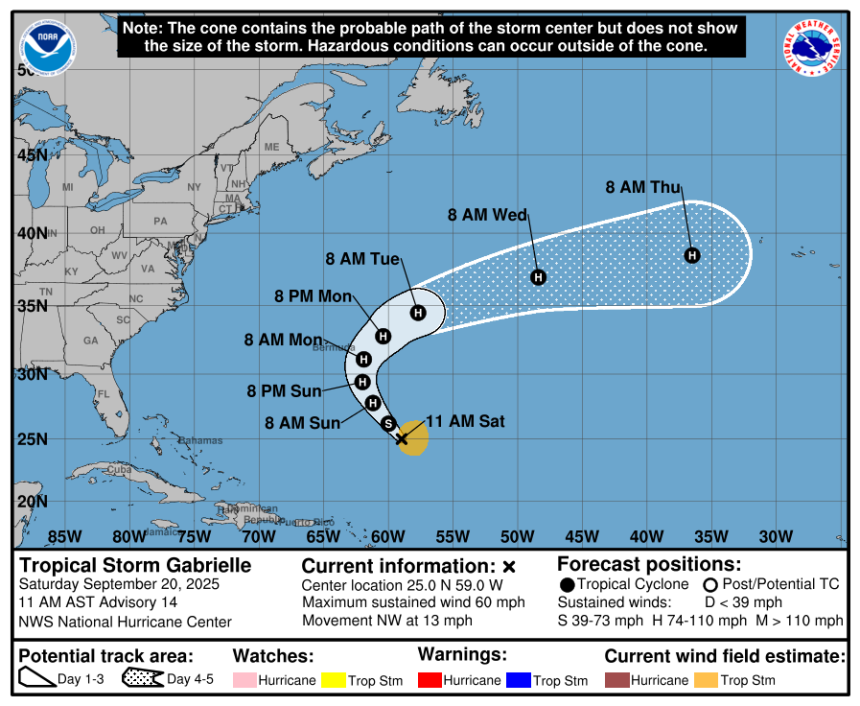Tropical Storm Gabrielle is revving up in the Atlantic but is not forecasted to make an impact on land.
The storm is forecasted by the National Hurricane Center to become a hurricane by Sept. 21, and pass east of Bermuda. The storm could become a Category 2 storm with 105-mile-per-hour sustained winds, but will weaken as it continues trekking eastward.
It will send waves to Delaware and most of the rest of the Mid-Atlantic coast, but it will be very manageable and not nearly as big as Hurricane Erin’s monster swell. Still, the surf could be dangerous, and rip currents will be more intense as a result of the swell.
Track and cone forecast for Tropical Storm Gabrielle from the National Hurricane Center on Sep. 20, 2025
There is another system in the works in the Atlantic, according to National Hurricane Center data, with a 20% chance of becoming a tropical cyclone within the week.
Tropical Storm Gabrielle spaghetti models
Illustrations include an array of forecast tools and models, and not all are created equal. The hurricane center uses only the top four or five highest-performing models to help make its forecasts.
A historic hurricane season ‘shutout’
The lull in Atlantic storms is newsworthy: In the modern satellite era (since 1966), “we’ve never seen a shutout” during this very active window of the season, when, on average four named storms and two hurricanes form each season, WPLG-TV hurricane specialist Michael Lowry said.
So far this season, the Atlantic basin has recorded the lowest activity since 2014 and, with only one hurricane so far (Category 5 Hurricane Erin), the fewest hurricanes through Sept. 15 since 2002, he added.
The quiet season is in stark contrast to most preseason forecasts, which called for an unusually active year. For example, the National Oceanic and Atmospheric Administration said that as many as 19 named storms could form this year.
When does hurricane season end?
Hurricane season runs through Nov. 30. However, hurricanes can occur before and after those dates.
What are the categories for tropical cyclones and hurricanes?
Tropical storm
A tropical storm is a tropical cyclone with winds between 39 and 73 mph. These storms bring heavy rains that could lead to dangerous flooding.
Category 1
A category 1 storm is the weakest of the hurricanes with winds between 74 and 95 mph. The storm will cause some flooding, but no real structural damage.
Category 2
A category 2 storm has winds between 96 and 110 mph. The storm can cause moderate damage to buildings.
Category 3
A category 3 storm will have winds from 111-129 mph. It can cause major damage to well-built framed homes, uproot trees and cause power and communication outages.
Category 4
A category 4 storm can cause catastrophic damage to well-built framed homes, tearing off roofs and breaking exterior walls. Mobile homes are destroyed. Roads are impassible and there are communication and power outages.
Category 5
A category 5 storm can cause catastrophic damage with most framed homes and mobile homes being destroyed. Trees will be snapped and uprooted. Roads will be impassible and there will be extended power and communication outages.
Prepare now for hurricanes
Delaying potentially lifesaving preparations could mean waiting until it’s too late. “Get your disaster supplies while the shelves are still stocked, and get that insurance checkup early, as flood insurance requires a 30-day waiting period,” the National Oceanic and Atmospheric Administration recommends.
-
Develop an evacuation plan. If you are at risk from hurricanes, you need an evacuation plan. Now is the time to begin planning where you would go and how you would get there.
-
Assemble disaster supplies. Whether you’re evacuating or sheltering in place, you’re going to need supplies not just to get through the storm but for a possibly lengthy aftermath, NOAA said.
-
Get an insurance checkup and document your possessions. Contact your insurance company or agent now and ask for an insurance checkup to make sure you have enough insurance to repair or even replace your home and belongings. Remember, home and renters insurance don’t cover flooding, so you’ll need a separate policy for those. Flood insurance is available through your company, agent or the National Flood Insurance Program.
-
Create a family communication plan. NOAA says you should take the time now to write down a hurricane plan and share it with your family. Determine family meeting places and make sure to include an out-of-town location in case of evacuation.
-
Strengthen your home. Now is the time to improve your home’s ability to withstand hurricanes. Trim trees and install storm shutters, accordion shutters and impact glass, and seal outside wall openings.
This article originally appeared on Delaware News Journal: Tropical Storm Gabrielle will get stronger. What should DE expect?









